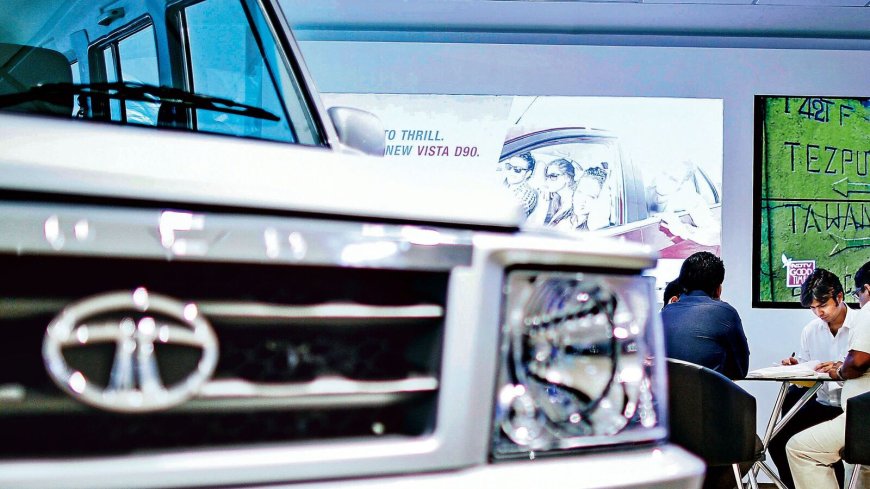Tata Motors Share Price Jumps 4% on CV Business Demerger Progress and India-UK FTA Developments
Tata Motors surged 4% in early trade as investors cheered progress in the commercial vehicle demerger and positive signals from India-UK Free Trade Agreement talks. Here’s what it means for long-term growth.

Tata Motors Share Price Rises 4% on CV Business Demerger Progress and India-UK Free Trade Agreement — Explained
Introduction: Tata Motors Powers Ahead with Clarity and Confidence
Tata Motors, one of India’s most iconic automobile manufacturers, saw its stock rise by nearly 4% in today’s trading session, reflecting investor optimism over two key strategic developments — the progress in demerging its Commercial Vehicle (CV) business and the advancing India-UK Free Trade Agreement (FTA) negotiations.
These twin tailwinds are being viewed as structural shifts in how Tata Motors plans to unlock value, both domestically and globally. As global and local dynamics converge, the company’s roadmap is garnering renewed interest from long-term investors and analysts alike.
But what’s driving the excitement? Let’s break it down.
Section 1: Tata Motors Stock Performance — The Snapshot
Market Reaction at a Glance
-
Intraday Surge: Tata Motors stock surged by 4% to touch ₹1,080 on the NSE before closing at ₹1,066, up ₹42 from the previous session.
-
52-Week Range: The stock is now just a whisker away from its 52-week high of ₹1,098.
-
Volume Spike: Trading volumes jumped nearly 38% over the daily average, reflecting renewed interest from institutional buyers.
This surge is not just a knee-jerk reaction. It stems from two deeply strategic developments reshaping the company’s future.
Section 2: CV Business Demerger — The Game-Changer
What is Happening?
Tata Motors recently made significant progress in its plan to demerge its Commercial Vehicles (CV) business, which includes trucks, buses, and electric commercial transport.
The demerger aims to unlock shareholder value, streamline operations, and allow both passenger and commercial vehicle units to chart independent, focused growth paths.
Why Does It Matter?
-
Separate Management Structures: The demerger will enable more agile decision-making, faster product innovation, and distinct capital allocation.
-
Improved Transparency: Investors will be able to evaluate each unit on its own financial and operational merit.
-
Listing Possibility: Analysts speculate that the CV business could eventually see a separate listing, attracting fresh capital from strategic investors or private equity.
Investor Sentiment
Brokerages like Motilal Oswal and Jefferies have given a positive outlook, noting that the demerger could lead to a 15–20% re-rating in Tata Motors’ stock post-restructuring.
Section 3: Commercial Vehicle Business — The Unsung Growth Driver
India’s CV Market is Rebounding
India’s CV segment, particularly medium and heavy commercial vehicles (MHCVs), is witnessing a strong revival in FY25 due to:
-
Increased infrastructure spending
-
Higher freight demand
-
New BS-VI Phase II norms increasing vehicle prices (benefiting OEM margins)
Tata Motors, with a market share of over 40% in CVs, stands to gain massively. The demerger ensures focused attention on scaling this profitable vertical.
Section 4: India-UK Free Trade Agreement — A Global Catalyst
How the FTA Helps Tata Motors and JLR
The proposed India-UK Free Trade Agreement, now in advanced negotiation stages, is expected to lower tariffs on automobile exports between the two nations. This would be a huge win for Jaguar Land Rover (JLR) — Tata’s luxury subsidiary based in the UK.
Key Implications:
-
Tariff Reduction: Import duties on electric vehicles and high-end cars may be reduced or eliminated.
-
Market Expansion: Easier access for JLR to Indian markets and vice versa.
-
Supply Chain Integration: Better alignment of production and distribution logistics across UK and India.
This FTA comes at a time when JLR is revamping its EV roadmap under the “Reimagine” strategy, which aligns perfectly with global trade relaxation.
Section 5: Tata Motors' Strong Fundamentals
Balance Sheet Strength
Tata Motors has seen a remarkable turnaround in its financial health:
-
Net Automotive Debt: Reduced significantly from ₹61,000 crore in FY21 to below ₹20,000 crore in FY24.
-
Consolidated EBITDA Margin: Improved from 9% to nearly 13% YoY.
-
Free Cash Flow: Turned consistently positive, led by strong JLR performance and domestic recovery.
The restructuring only strengthens this momentum.
Section 6: JLR Recovery and EV Push
Luxury Market Resurgence
JLR has returned to consistent profitability, driven by:
-
High-margin models like Range Rover, Defender, and Jaguar F-Pace
-
Lower discounts and premium pricing
-
Supply chain normalisation post-pandemic
Electric Vision
-
JLR plans to fully electrify Jaguar by 2025
-
First electric Range Rover to debut by 2024-end
-
Strategic tie-ups with Nvidia (for autonomous tech) and Tata Power (EV infra)
The India-UK FTA will be the cherry on top, easing market entry for JLR EVs into India and the EU via trade corridors.
Section 7: Analysts’ Take on Tata Motors
Brokerage Ratings
| Brokerage | Target Price | Outlook |
|---|---|---|
| Morgan Stanley | ₹1,250 | Overweight |
| CLSA | ₹1,180 | Buy |
| ICICI Securities | ₹1,210 | Strong Buy |
| Nomura | ₹1,150 | Buy |
They cite CV demerger clarity, JLR tailwinds, and improving return ratios as key factors for bullishness.
Section 8: Technical Outlook — Breakout Confirmed?
Momentum Indicators
-
RSI: Currently at 68 — edging close to overbought, but still bullish.
-
MACD: Positive crossover visible on the daily chart.
-
Support Levels: Strong support at ₹1,020 and ₹995.
-
Resistance: Eyes set on ₹1,098, post which a fresh breakout could trigger toward ₹1,150.
This reinforces confidence that the stock’s rally is technically backed, not just news-driven.
Section 9: What’s Next for Tata Motors Investors?
Short-Term Catalysts
-
Final blueprint of CV demerger
-
India-UK FTA announcement (likely in the coming months)
-
JLR’s next EV rollout
Medium-Term Vision
-
Separate listing for CV division
-
JLR’s EV export scale-up
-
Auto sector tailwinds post-election budget
Long-Term Horizon
Tata Motors is emerging as a global mobility powerhouse, spanning mass-market passenger vehicles, premium luxury (via JLR), and electric mobility. Structural tailwinds — both local and global — now converge to fuel its next phase of growth.
Value Unlocked, Vision Aligned
The 4% jump in Tata Motors share price is not a flash in the pan. It reflects deeper confidence in the company’s ability to execute bold structural reforms — such as the CV demerger — while also capitalizing on global trade shifts like the India-UK FTA.
As India’s mobility landscape evolves, Tata Motors appears well-positioned to lead from the front — whether it’s trucks rolling on Indian highways or luxury EVs cruising through London streets.
For investors who value resilience, vision, and global potential, Tata Motors continues to rev its engine — and this time, it’s not slowing down.
What's Your Reaction?
 Like
0
Like
0
 Dislike
0
Dislike
0
 Love
0
Love
0
 Funny
0
Funny
0
 Angry
0
Angry
0
 Sad
0
Sad
0
 Wow
0
Wow
0












































































